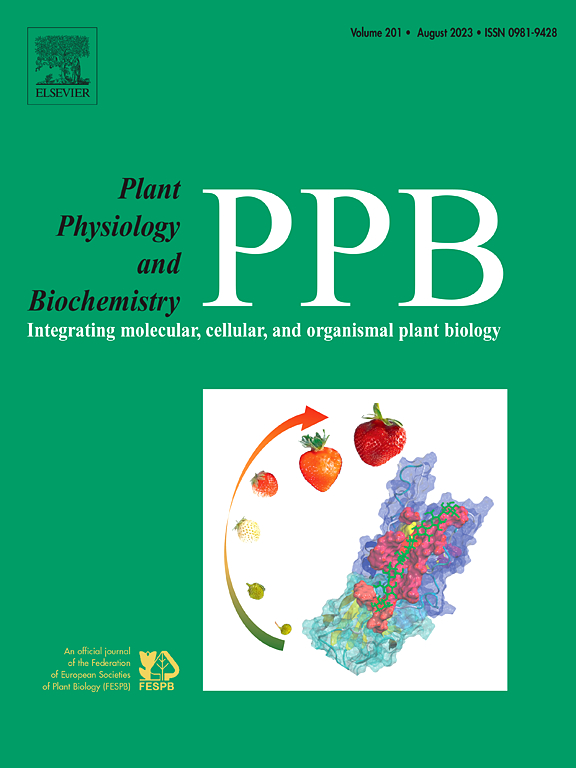综合表型、细胞学、生理学和转录组学分析,为植物矮化提供了新的思路
IF 6.1
2区 生物学
Q1 PLANT SCIENCES
引用次数: 0
摘要
糜子是最节水的谷类作物之一。然而,关于其株高与抗倒伏和产量密切相关的调控机制的研究却很少报道。本研究利用甲基磺酸(EMS)诱变法制备了一株矮突变体778。利用表型、细胞学和转录组学方法对其矮化机理进行了分析。778在整个个体发生周期中表现出矮化表型。与野生型260相比,778的分蘖数和前序叶宽度显著增加,花梗长度、穗长和千粒重显著减少。主茎的细胞学分析显示纵向细胞的长度减少。喷施GA3后,778株株高显著升高,属于GA3敏感矮秆突变体。转录组分析显示,差异表达基因(DEGs)在778 ~ 260个之间,共337个,根据GO和KEGG的富集程度,差异表达基因主要涉及四个方面。对其中一个侏儒相关基因TD1进行克隆和测序,发现778在终止密码子前缺少58个碱基。构建了TD1同源基因CLV1的反义过表达载体,并转化到拟南芥中。观察到转基因植株高度降低,表明抑制CLV1表达可能导致植株矮化。因此,推测TD1突变可能是导致778矮化的关键因素。这一综合分析为了解糜子矮化机理提供了有价值的见解。本文章由计算机程序翻译,如有差异,请以英文原文为准。
Integrated phenotypic, cytological, physiological and transcriptomic analyses of Panicum miliaceum L. provide insights into the plant dwarfing
Broomcorn millet is one of the most water-saving cereal crops. However, studies on regulatory mechanisms of its plant height that are closely associated with lodging resistance and yield are rarely reported. In this study, a dwarf mutant in broomcorn millet, designated as 778, was generated by ethyl methyl sulfonic acid (EMS) mutagenesis. Its dwarfing mechanism was analyzed using phenotypic, cytological and transcriptomic methods. 778 exhibited a dwarfing phenotype throughout its entire ontogenetic cycle. Compared with the wild type 260, 778 exhibited significant increases in tiller number and the antepenultimate leaf width, alongside a significant reduction in pedicel length, spike length and 1000-grain weight. Cytological analysis of the main stem revealed decreases in the length of longitudinal cells. After spraying gibberellic acid 3 (GA3), the height of 778 significantly increased, confirming its classification as a GA3-sensitive dwarf mutant. Transcriptome analysis showed 337 differentially expressed genes (DEGs) between 778 and 260, which were mainly involved in four aspects according to enrichment of GO and KEGG. One dwarf-related gene TD1 was cloned and sequenced, revealing that 778 lacked 58 bases before the termination codon. An antisense over-expression vector of CLV1, a TD1 homologous gene, was constructed and transformed into Arabidopsis thaliana. It was observed that the height of transgenic plants was reduced, indicating that inhibition of CLV1 expression might lead to dwarfing. Therefore, it is speculated that TD1 mutation may be a critical factor contributing to the dwarfing of 778. This integrated analyses provides valuable insights into the dwarf mechanism of broomcorn millet.
求助全文
通过发布文献求助,成功后即可免费获取论文全文。
去求助
来源期刊
CiteScore
11.10
自引率
3.10%
发文量
410
审稿时长
33 days
期刊介绍:
Plant Physiology and Biochemistry publishes original theoretical, experimental and technical contributions in the various fields of plant physiology (biochemistry, physiology, structure, genetics, plant-microbe interactions, etc.) at diverse levels of integration (molecular, subcellular, cellular, organ, whole plant, environmental). Opinions expressed in the journal are the sole responsibility of the authors and publication does not imply the editors'' agreement.
Manuscripts describing molecular-genetic and/or gene expression data that are not integrated with biochemical analysis and/or actual measurements of plant physiological processes are not suitable for PPB. Also "Omics" studies (transcriptomics, proteomics, metabolomics, etc.) reporting descriptive analysis without an element of functional validation assays, will not be considered. Similarly, applied agronomic or phytochemical studies that generate no new, fundamental insights in plant physiological and/or biochemical processes are not suitable for publication in PPB.
Plant Physiology and Biochemistry publishes several types of articles: Reviews, Papers and Short Papers. Articles for Reviews are either invited by the editor or proposed by the authors for the editor''s prior agreement. Reviews should not exceed 40 typewritten pages and Short Papers no more than approximately 8 typewritten pages. The fundamental character of Plant Physiology and Biochemistry remains that of a journal for original results.

 求助内容:
求助内容: 应助结果提醒方式:
应助结果提醒方式:


